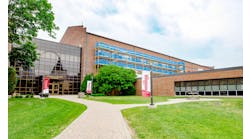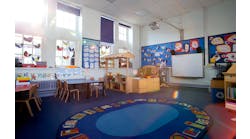The way inanimate objects come to life in nature is through an interplay with the sunlight, shadows and weather conditions that move across them. In spite of their immobility, the appearance of these stationary objects is constantly changing. It is a major lesson of the natural environment.
The built environment also is inanimate. Building facades rely upon the moving sun to bring them to life. It is equally important that the interiors of buildings come to life. Part of the task for designers is to apply nature's lighting lesson to the interior of buildings. And where is it more important to apply such a lesson than in school design?
Seeing daylight
The useful visible sunlight that penetrates the building skin is called daylighting. Solar radiation has three components defined by wavelength: short-wave ultraviolet, visible light and long-wave infrared (heat). When visible sunlight reaches a window surface, it is “white” light, a mixture of the entire color spectrum. The atmosphere and cloud cover, on any given day, filter the solar radiation before it arrives at the building.
As the Earth moves around the sun, the relationship of the sun and the building changes gradually. The sun's angle to the building is wider in the summer months and narrower in the winter months. The smaller the angle between the glazed surface on the building and the sun, the more it is reflected and the less direct sunlight actually penetrates the building.
Fortunately, a portion of the light reflected from the immediate environment of the building during the day bounces into the building from every direction. Cloud cover and atmosphere also can serve to reflect light back to Earth. This is how useful sunlight gets to the surfaces of a building that do not “see” the sun directly. This reflected light can be maximized when the building is adjacent to water or when the building is situated in a climate where snow is abundant. In winter, of course, fewer hours of daylight are available.
Each type of “clear” glass (or other transparent surface) will reflect, absorb or transmit varying degrees of each type of solar radiation. The amount will depend on the angle of arrival and chemical composition of the glass. “Tinted” glass transmits only a preferred color of visible light and reduces glare. “Reflective” glass reflects light to a much higher degree than does clear glass. “Low-e” glass has an applied reflecting surface that reflects radiated heat back to the side of the window from which it originated.
In other words, glass also “filters” the incoming light (and heat) to varying degrees. Double-glazed windows filter light at each pane. Laminated glass also has the effect of filtering depending upon how many layers of glass are sandwiched into the lamination. The adhesive interlayer between laminations also filters incoming light.
Once light enters a building, it strikes the various interior surfaces of the building space and is again reflected, absorbed or transmitted. The darker the surface, the more light is absorbed. Lighter surfaces will reflect more light. A rough or textured surface splays the light as it reflects it. Direct solar radiation also can bleach fabric. If the same sunlight strikes a green leaf, it can cause photosynthesis and result in oxygen being produced inside the building.
Shadows will be cast on the interior surfaces of the building by anything that impedes the transmission of direct sunlight through the transparent opening in the building. A rough rule of thumb is that a shadow less than three feet long will have a crisp black edge. When the length of the shadow exceeds three feet, the edge of the shadow will begin to become soft or fuzzy. The longer the shadow, the fuzzier its leading edge will be. As a result, shadows on the floor of a building cast by an adjacent window sill are likely to be sharper than shadows cast on the floor by a skylight.
All of this happens in the blink of an eye — at the speed of light. During daylight hours, we can expect a lighting contribution from the sun. How much we get and where we will find it depend upon how clever we are in understanding the relationship of the sun to a building.
Bringing light indoors
With the invention and frequent use of double glazing in the late 1970s, the cost of heat loss through a window in the winter was counterbalanced by the cost savings in artificial lighting. Even indirect daylighting on a cloudy day can help offset the cost of artificial light. Transparent low-e glass has made it possible to use more daylight while losing less heat. Another unique benefit of daylighting is that the light is “white” and does not favor a certain segment of the light spectrum; it does not change the color and appearance of what it is illuminating. Artificially duplicating white light in building interiors can be costly.
The variability of daylight makes it unreliable for high-performance tasks. For reading or writing from fixed classroom seating, too much daylight in a space can, for example, cause glare and can decrease text readability and reading comfort. It can, however, augment or even replace artificial ambient lighting — surrounding background illumination. In a corridor or entry with adequate windows or skylights, daylighting can suffice. Educational institutions that function at night must have sufficient artificial lighting, often for the same tasks that are performed during the day. For such cases, there is no first-cost savings for daylighting over artificial illumination.
Libraries are spaces where the population and intensity of use is expected to vary. The librarians and staff are always present, and ambient daylight always has been welcome. It is the task lighting in a library that needs to be activated on demand. Of late, the introduction of multiple banks of computers to libraries often ruins the daylight potential by causing the window curtains to be drawn.
As illustrated by the library example, the cost efficiency of daylighting often depends upon the behavior of the building users. Too often, simply out of negligence, artificial lights are in full use even with sufficient daylight. Shades can be left in the “down” position by a previous class. Even when automatic light or motion sensors operate the classroom lights, the sensors are not able to sense the number of people in class.
When lights are activated on demand, the conscious “off/on” choice can create an undesirable circumstance. Gymnasiums and auditoriums for example, when built without access to daylighting, offer dark cavernous alternatives. They discourage occupant use when lights are turned off. One student shooting baskets in an empty gym can require full artificial illumination.
Regardless of the economic operational advantages mentioned, a vital continual benefit of daylight in a space is a building user's subconscious awareness that change and movement are constantly occurring — especially when the people are sedentary. If shadows are cast into the room, they move and even possibly disappear from view at times. As the natural light source changes direction, the light is reflected differently from each surface to each room occupant. The interior space is “alive” and directly linked to nature and nature's diurnal swing. This type of “cosmic glue” has proven to be revitalizing and have educational performance benefits. Daylight is itself both enlightening and educational.
NOTABLE
Types of glass:
▪ CLEAR
Each type of this glass will absorb or transmit varying degrees of each type of solar radiation depending on the angle of the arrival and chemical composition of the glass.
▪ TINTED
This glass transmits only a preferred color of visible light and reduces glare.
▪ REFLECTIVE
This type of glass reflects all light to a much higher degree than does clear glass.
▪ LOW-E
This glass has an applied reflecting surface that reflects radiated heat back to the side of the window from whence it came.
Rush is an architect with The Office of Michael Rosenfeld, Inc. Architects, West Acton, Mass.
